Sustainable Operations and Destinations Report - Uganda Case Study
VerifiedAdded on 2023/06/04
|6
|1538
|338
Report
AI Summary
This report analyzes sustainable operations and destinations, focusing on a case study of Uganda's tourism industry. It examines the impacts of tourism, both positive and negative, and emphasizes the importance of balancing economic benefits with environmental and social costs. The report identifies key stakeholders, including the University of Manitoba and Intrepid Travel, and explores their corporate social responsibility (CSR) practices in the context of a developing country. It addresses key issues in destination management, such as deforestation and community involvement, using the precaution and transparency principles. The analysis further discusses how intermediaries can support the 4Ps of sustainability (people, planet, profit, and progress) and highlights the significance of sustainable supply chains. Recommendations are provided to enhance the sustainability of tourism in Uganda, with a focus on forest restoration and civic education. The report concludes by emphasizing the need for coordination among stakeholders to promote sustainable tourism and CSR.
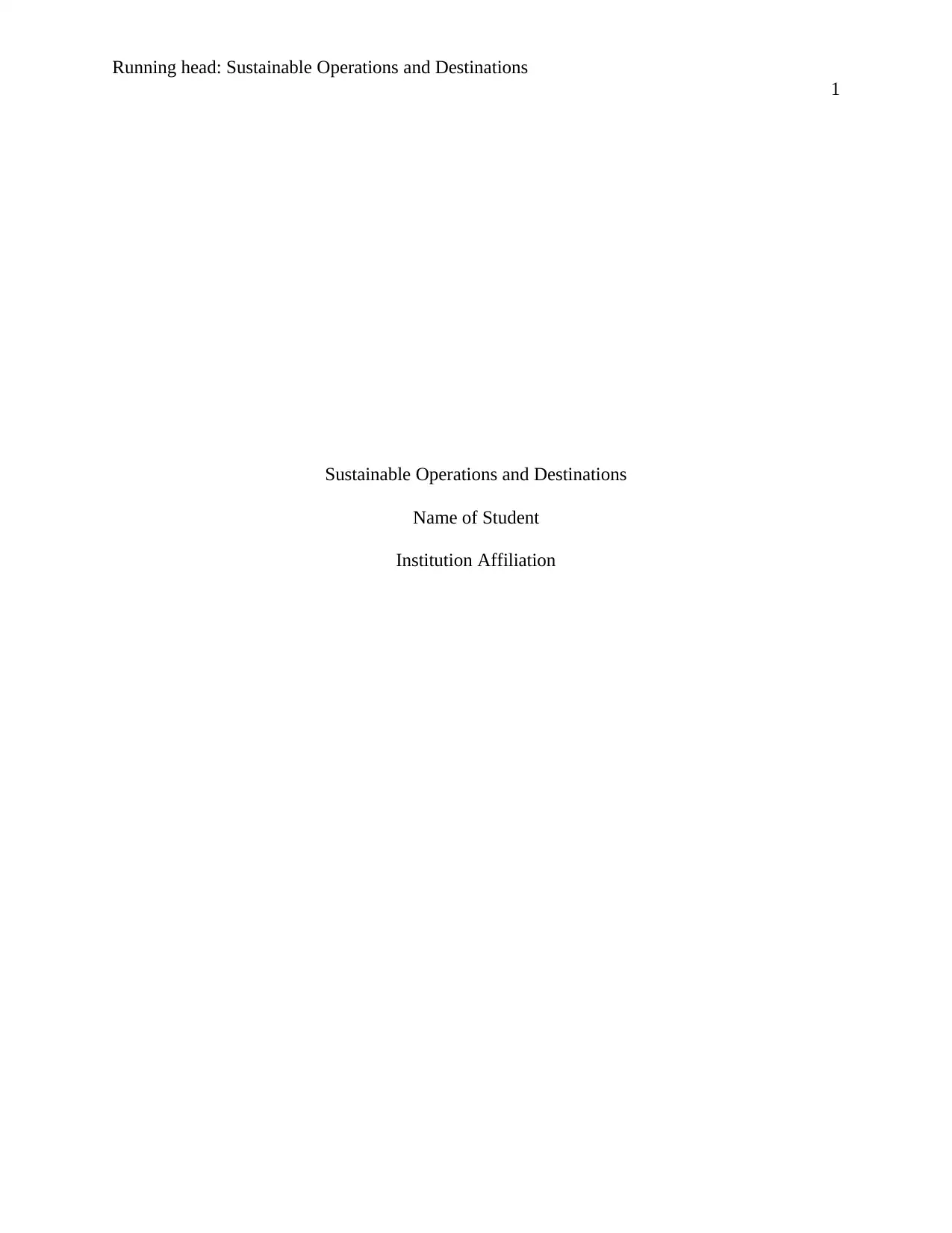
Running head: Sustainable Operations and Destinations
1
Sustainable Operations and Destinations
Name of Student
Institution Affiliation
1
Sustainable Operations and Destinations
Name of Student
Institution Affiliation
Paraphrase This Document
Need a fresh take? Get an instant paraphrase of this document with our AI Paraphraser
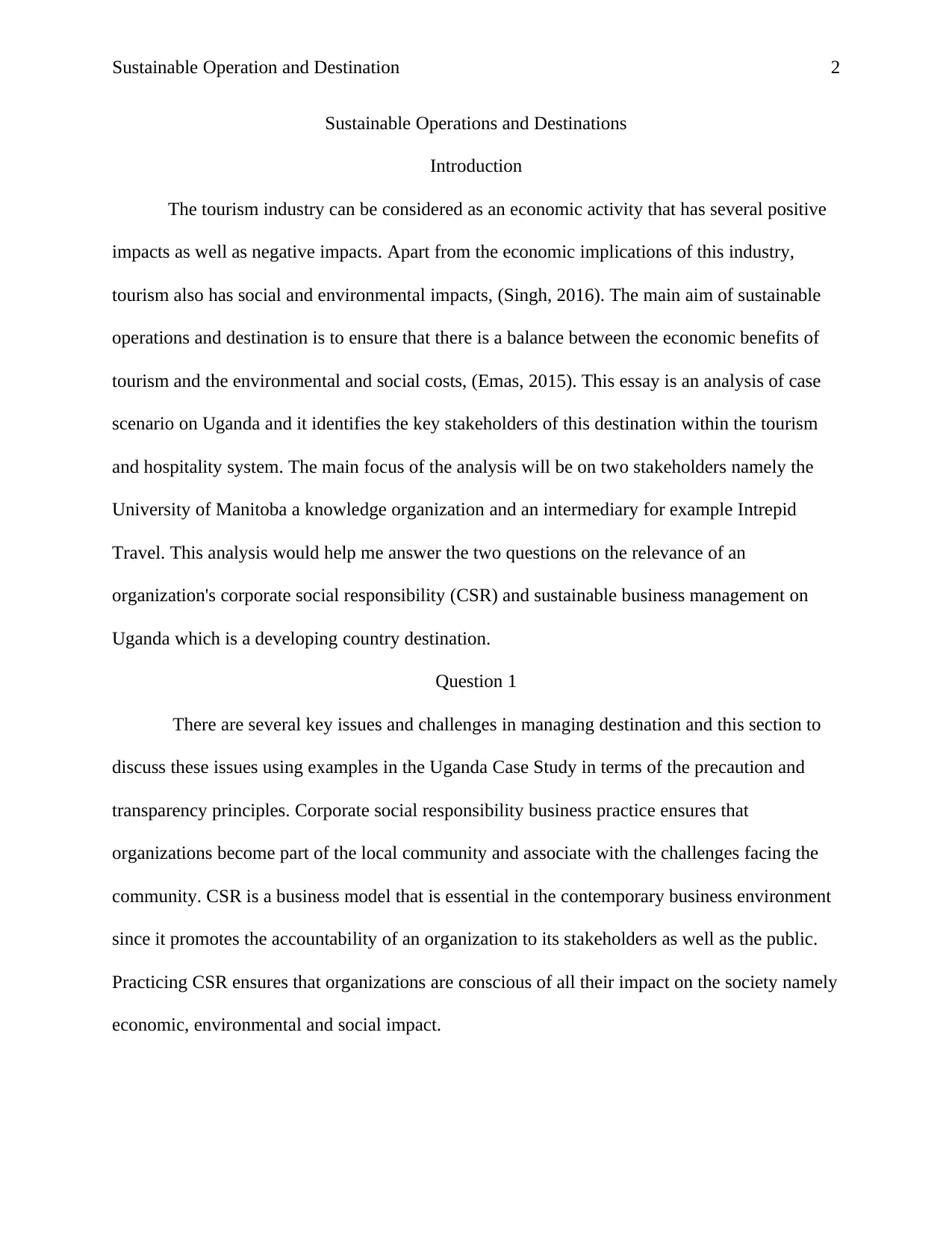
Sustainable Operation and Destination 2
Sustainable Operations and Destinations
Introduction
The tourism industry can be considered as an economic activity that has several positive
impacts as well as negative impacts. Apart from the economic implications of this industry,
tourism also has social and environmental impacts, (Singh, 2016). The main aim of sustainable
operations and destination is to ensure that there is a balance between the economic benefits of
tourism and the environmental and social costs, (Emas, 2015). This essay is an analysis of case
scenario on Uganda and it identifies the key stakeholders of this destination within the tourism
and hospitality system. The main focus of the analysis will be on two stakeholders namely the
University of Manitoba a knowledge organization and an intermediary for example Intrepid
Travel. This analysis would help me answer the two questions on the relevance of an
organization's corporate social responsibility (CSR) and sustainable business management on
Uganda which is a developing country destination.
Question 1
There are several key issues and challenges in managing destination and this section to
discuss these issues using examples in the Uganda Case Study in terms of the precaution and
transparency principles. Corporate social responsibility business practice ensures that
organizations become part of the local community and associate with the challenges facing the
community. CSR is a business model that is essential in the contemporary business environment
since it promotes the accountability of an organization to its stakeholders as well as the public.
Practicing CSR ensures that organizations are conscious of all their impact on the society namely
economic, environmental and social impact.
Sustainable Operations and Destinations
Introduction
The tourism industry can be considered as an economic activity that has several positive
impacts as well as negative impacts. Apart from the economic implications of this industry,
tourism also has social and environmental impacts, (Singh, 2016). The main aim of sustainable
operations and destination is to ensure that there is a balance between the economic benefits of
tourism and the environmental and social costs, (Emas, 2015). This essay is an analysis of case
scenario on Uganda and it identifies the key stakeholders of this destination within the tourism
and hospitality system. The main focus of the analysis will be on two stakeholders namely the
University of Manitoba a knowledge organization and an intermediary for example Intrepid
Travel. This analysis would help me answer the two questions on the relevance of an
organization's corporate social responsibility (CSR) and sustainable business management on
Uganda which is a developing country destination.
Question 1
There are several key issues and challenges in managing destination and this section to
discuss these issues using examples in the Uganda Case Study in terms of the precaution and
transparency principles. Corporate social responsibility business practice ensures that
organizations become part of the local community and associate with the challenges facing the
community. CSR is a business model that is essential in the contemporary business environment
since it promotes the accountability of an organization to its stakeholders as well as the public.
Practicing CSR ensures that organizations are conscious of all their impact on the society namely
economic, environmental and social impact.
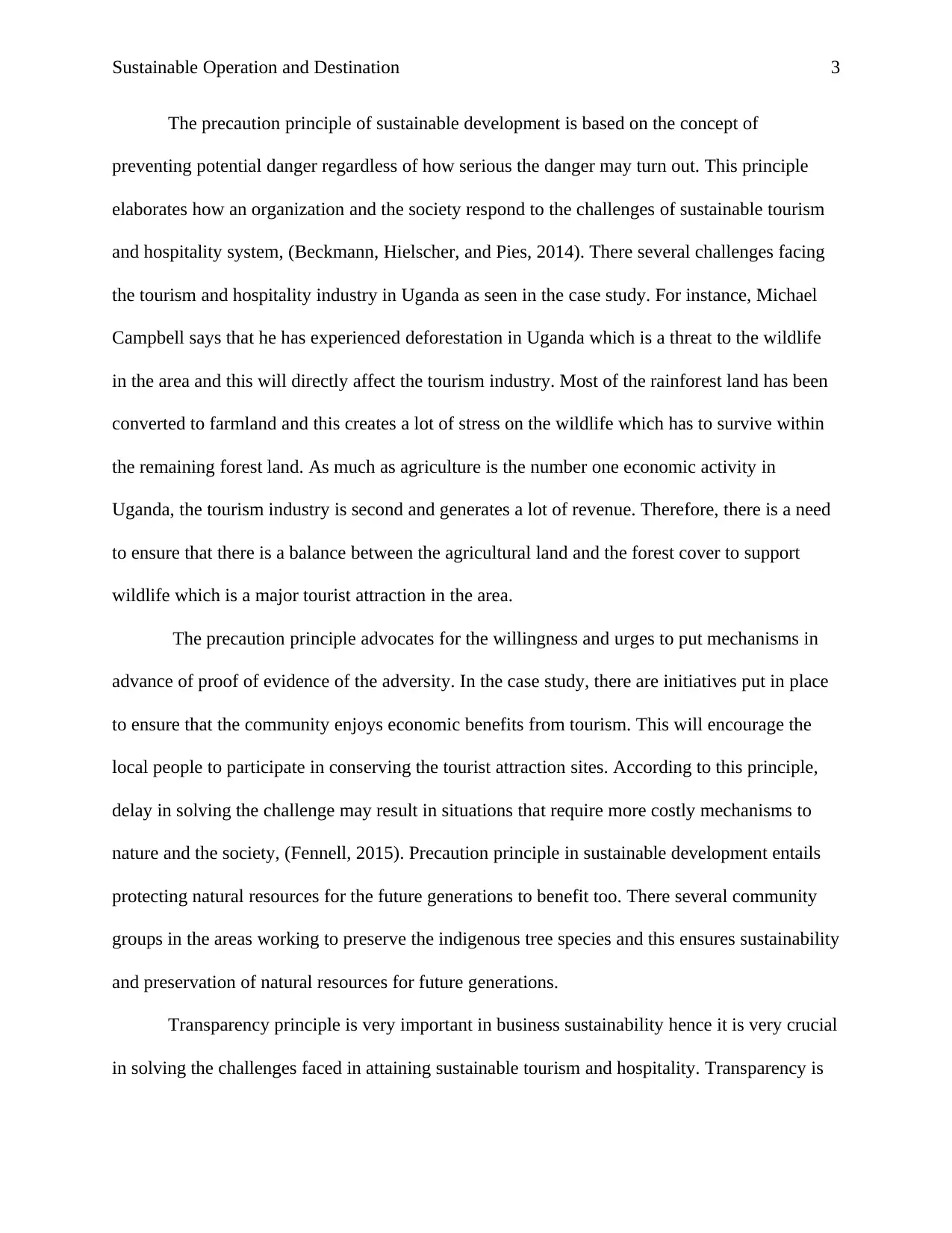
Sustainable Operation and Destination 3
The precaution principle of sustainable development is based on the concept of
preventing potential danger regardless of how serious the danger may turn out. This principle
elaborates how an organization and the society respond to the challenges of sustainable tourism
and hospitality system, (Beckmann, Hielscher, and Pies, 2014). There several challenges facing
the tourism and hospitality industry in Uganda as seen in the case study. For instance, Michael
Campbell says that he has experienced deforestation in Uganda which is a threat to the wildlife
in the area and this will directly affect the tourism industry. Most of the rainforest land has been
converted to farmland and this creates a lot of stress on the wildlife which has to survive within
the remaining forest land. As much as agriculture is the number one economic activity in
Uganda, the tourism industry is second and generates a lot of revenue. Therefore, there is a need
to ensure that there is a balance between the agricultural land and the forest cover to support
wildlife which is a major tourist attraction in the area.
The precaution principle advocates for the willingness and urges to put mechanisms in
advance of proof of evidence of the adversity. In the case study, there are initiatives put in place
to ensure that the community enjoys economic benefits from tourism. This will encourage the
local people to participate in conserving the tourist attraction sites. According to this principle,
delay in solving the challenge may result in situations that require more costly mechanisms to
nature and the society, (Fennell, 2015). Precaution principle in sustainable development entails
protecting natural resources for the future generations to benefit too. There several community
groups in the areas working to preserve the indigenous tree species and this ensures sustainability
and preservation of natural resources for future generations.
Transparency principle is very important in business sustainability hence it is very crucial
in solving the challenges faced in attaining sustainable tourism and hospitality. Transparency is
The precaution principle of sustainable development is based on the concept of
preventing potential danger regardless of how serious the danger may turn out. This principle
elaborates how an organization and the society respond to the challenges of sustainable tourism
and hospitality system, (Beckmann, Hielscher, and Pies, 2014). There several challenges facing
the tourism and hospitality industry in Uganda as seen in the case study. For instance, Michael
Campbell says that he has experienced deforestation in Uganda which is a threat to the wildlife
in the area and this will directly affect the tourism industry. Most of the rainforest land has been
converted to farmland and this creates a lot of stress on the wildlife which has to survive within
the remaining forest land. As much as agriculture is the number one economic activity in
Uganda, the tourism industry is second and generates a lot of revenue. Therefore, there is a need
to ensure that there is a balance between the agricultural land and the forest cover to support
wildlife which is a major tourist attraction in the area.
The precaution principle advocates for the willingness and urges to put mechanisms in
advance of proof of evidence of the adversity. In the case study, there are initiatives put in place
to ensure that the community enjoys economic benefits from tourism. This will encourage the
local people to participate in conserving the tourist attraction sites. According to this principle,
delay in solving the challenge may result in situations that require more costly mechanisms to
nature and the society, (Fennell, 2015). Precaution principle in sustainable development entails
protecting natural resources for the future generations to benefit too. There several community
groups in the areas working to preserve the indigenous tree species and this ensures sustainability
and preservation of natural resources for future generations.
Transparency principle is very important in business sustainability hence it is very crucial
in solving the challenges faced in attaining sustainable tourism and hospitality. Transparency is
⊘ This is a preview!⊘
Do you want full access?
Subscribe today to unlock all pages.

Trusted by 1+ million students worldwide
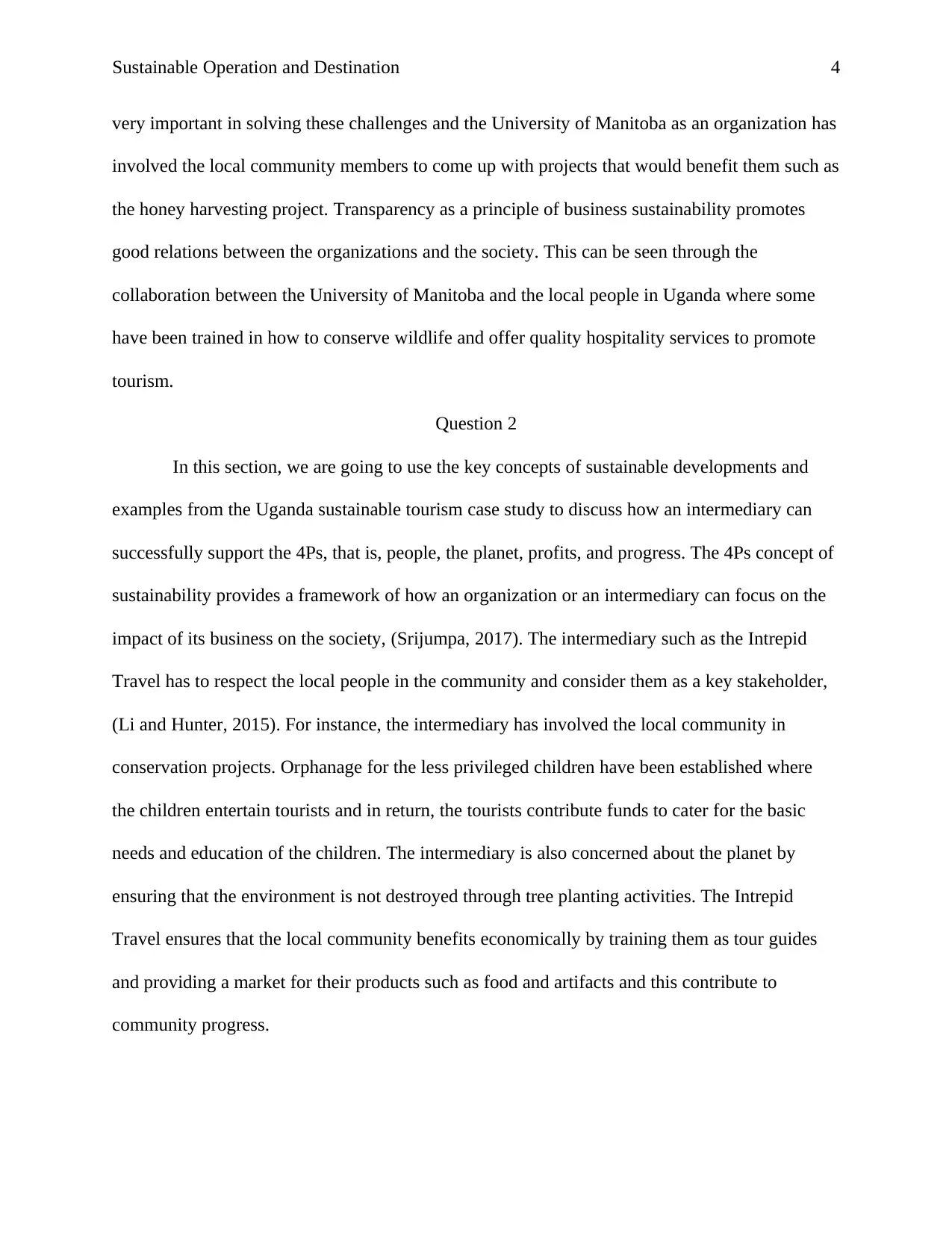
Sustainable Operation and Destination 4
very important in solving these challenges and the University of Manitoba as an organization has
involved the local community members to come up with projects that would benefit them such as
the honey harvesting project. Transparency as a principle of business sustainability promotes
good relations between the organizations and the society. This can be seen through the
collaboration between the University of Manitoba and the local people in Uganda where some
have been trained in how to conserve wildlife and offer quality hospitality services to promote
tourism.
Question 2
In this section, we are going to use the key concepts of sustainable developments and
examples from the Uganda sustainable tourism case study to discuss how an intermediary can
successfully support the 4Ps, that is, people, the planet, profits, and progress. The 4Ps concept of
sustainability provides a framework of how an organization or an intermediary can focus on the
impact of its business on the society, (Srijumpa, 2017). The intermediary such as the Intrepid
Travel has to respect the local people in the community and consider them as a key stakeholder,
(Li and Hunter, 2015). For instance, the intermediary has involved the local community in
conservation projects. Orphanage for the less privileged children have been established where
the children entertain tourists and in return, the tourists contribute funds to cater for the basic
needs and education of the children. The intermediary is also concerned about the planet by
ensuring that the environment is not destroyed through tree planting activities. The Intrepid
Travel ensures that the local community benefits economically by training them as tour guides
and providing a market for their products such as food and artifacts and this contribute to
community progress.
very important in solving these challenges and the University of Manitoba as an organization has
involved the local community members to come up with projects that would benefit them such as
the honey harvesting project. Transparency as a principle of business sustainability promotes
good relations between the organizations and the society. This can be seen through the
collaboration between the University of Manitoba and the local people in Uganda where some
have been trained in how to conserve wildlife and offer quality hospitality services to promote
tourism.
Question 2
In this section, we are going to use the key concepts of sustainable developments and
examples from the Uganda sustainable tourism case study to discuss how an intermediary can
successfully support the 4Ps, that is, people, the planet, profits, and progress. The 4Ps concept of
sustainability provides a framework of how an organization or an intermediary can focus on the
impact of its business on the society, (Srijumpa, 2017). The intermediary such as the Intrepid
Travel has to respect the local people in the community and consider them as a key stakeholder,
(Li and Hunter, 2015). For instance, the intermediary has involved the local community in
conservation projects. Orphanage for the less privileged children have been established where
the children entertain tourists and in return, the tourists contribute funds to cater for the basic
needs and education of the children. The intermediary is also concerned about the planet by
ensuring that the environment is not destroyed through tree planting activities. The Intrepid
Travel ensures that the local community benefits economically by training them as tour guides
and providing a market for their products such as food and artifacts and this contribute to
community progress.
Paraphrase This Document
Need a fresh take? Get an instant paraphrase of this document with our AI Paraphraser
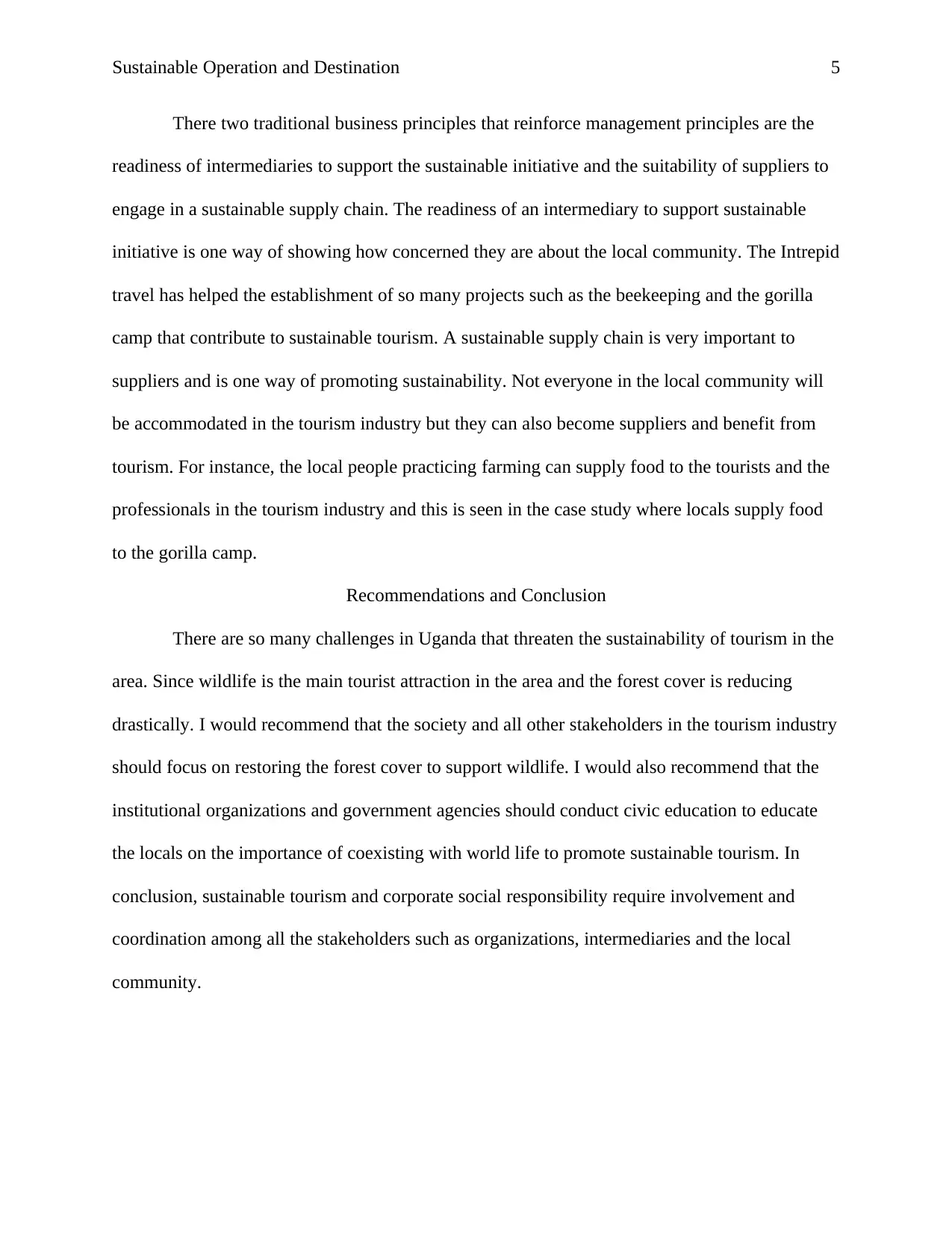
Sustainable Operation and Destination 5
There two traditional business principles that reinforce management principles are the
readiness of intermediaries to support the sustainable initiative and the suitability of suppliers to
engage in a sustainable supply chain. The readiness of an intermediary to support sustainable
initiative is one way of showing how concerned they are about the local community. The Intrepid
travel has helped the establishment of so many projects such as the beekeeping and the gorilla
camp that contribute to sustainable tourism. A sustainable supply chain is very important to
suppliers and is one way of promoting sustainability. Not everyone in the local community will
be accommodated in the tourism industry but they can also become suppliers and benefit from
tourism. For instance, the local people practicing farming can supply food to the tourists and the
professionals in the tourism industry and this is seen in the case study where locals supply food
to the gorilla camp.
Recommendations and Conclusion
There are so many challenges in Uganda that threaten the sustainability of tourism in the
area. Since wildlife is the main tourist attraction in the area and the forest cover is reducing
drastically. I would recommend that the society and all other stakeholders in the tourism industry
should focus on restoring the forest cover to support wildlife. I would also recommend that the
institutional organizations and government agencies should conduct civic education to educate
the locals on the importance of coexisting with world life to promote sustainable tourism. In
conclusion, sustainable tourism and corporate social responsibility require involvement and
coordination among all the stakeholders such as organizations, intermediaries and the local
community.
There two traditional business principles that reinforce management principles are the
readiness of intermediaries to support the sustainable initiative and the suitability of suppliers to
engage in a sustainable supply chain. The readiness of an intermediary to support sustainable
initiative is one way of showing how concerned they are about the local community. The Intrepid
travel has helped the establishment of so many projects such as the beekeeping and the gorilla
camp that contribute to sustainable tourism. A sustainable supply chain is very important to
suppliers and is one way of promoting sustainability. Not everyone in the local community will
be accommodated in the tourism industry but they can also become suppliers and benefit from
tourism. For instance, the local people practicing farming can supply food to the tourists and the
professionals in the tourism industry and this is seen in the case study where locals supply food
to the gorilla camp.
Recommendations and Conclusion
There are so many challenges in Uganda that threaten the sustainability of tourism in the
area. Since wildlife is the main tourist attraction in the area and the forest cover is reducing
drastically. I would recommend that the society and all other stakeholders in the tourism industry
should focus on restoring the forest cover to support wildlife. I would also recommend that the
institutional organizations and government agencies should conduct civic education to educate
the locals on the importance of coexisting with world life to promote sustainable tourism. In
conclusion, sustainable tourism and corporate social responsibility require involvement and
coordination among all the stakeholders such as organizations, intermediaries and the local
community.
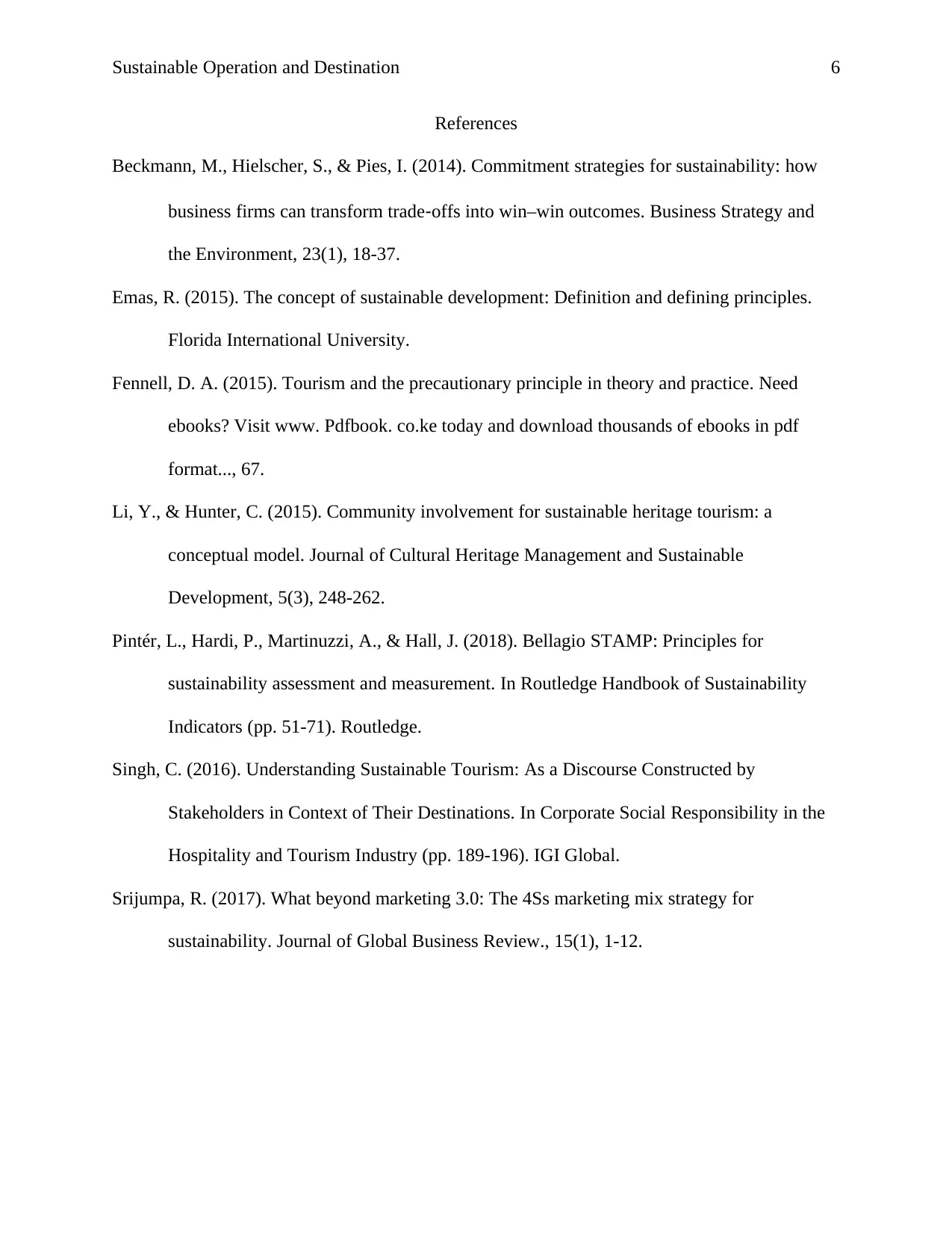
Sustainable Operation and Destination 6
References
Beckmann, M., Hielscher, S., & Pies, I. (2014). Commitment strategies for sustainability: how
business firms can transform trade‐offs into win–win outcomes. Business Strategy and
the Environment, 23(1), 18-37.
Emas, R. (2015). The concept of sustainable development: Definition and defining principles.
Florida International University.
Fennell, D. A. (2015). Tourism and the precautionary principle in theory and practice. Need
ebooks? Visit www. Pdfbook. co.ke today and download thousands of ebooks in pdf
format..., 67.
Li, Y., & Hunter, C. (2015). Community involvement for sustainable heritage tourism: a
conceptual model. Journal of Cultural Heritage Management and Sustainable
Development, 5(3), 248-262.
Pintér, L., Hardi, P., Martinuzzi, A., & Hall, J. (2018). Bellagio STAMP: Principles for
sustainability assessment and measurement. In Routledge Handbook of Sustainability
Indicators (pp. 51-71). Routledge.
Singh, C. (2016). Understanding Sustainable Tourism: As a Discourse Constructed by
Stakeholders in Context of Their Destinations. In Corporate Social Responsibility in the
Hospitality and Tourism Industry (pp. 189-196). IGI Global.
Srijumpa, R. (2017). What beyond marketing 3.0: The 4Ss marketing mix strategy for
sustainability. Journal of Global Business Review., 15(1), 1-12.
References
Beckmann, M., Hielscher, S., & Pies, I. (2014). Commitment strategies for sustainability: how
business firms can transform trade‐offs into win–win outcomes. Business Strategy and
the Environment, 23(1), 18-37.
Emas, R. (2015). The concept of sustainable development: Definition and defining principles.
Florida International University.
Fennell, D. A. (2015). Tourism and the precautionary principle in theory and practice. Need
ebooks? Visit www. Pdfbook. co.ke today and download thousands of ebooks in pdf
format..., 67.
Li, Y., & Hunter, C. (2015). Community involvement for sustainable heritage tourism: a
conceptual model. Journal of Cultural Heritage Management and Sustainable
Development, 5(3), 248-262.
Pintér, L., Hardi, P., Martinuzzi, A., & Hall, J. (2018). Bellagio STAMP: Principles for
sustainability assessment and measurement. In Routledge Handbook of Sustainability
Indicators (pp. 51-71). Routledge.
Singh, C. (2016). Understanding Sustainable Tourism: As a Discourse Constructed by
Stakeholders in Context of Their Destinations. In Corporate Social Responsibility in the
Hospitality and Tourism Industry (pp. 189-196). IGI Global.
Srijumpa, R. (2017). What beyond marketing 3.0: The 4Ss marketing mix strategy for
sustainability. Journal of Global Business Review., 15(1), 1-12.
⊘ This is a preview!⊘
Do you want full access?
Subscribe today to unlock all pages.

Trusted by 1+ million students worldwide
1 out of 6
Related Documents
Your All-in-One AI-Powered Toolkit for Academic Success.
+13062052269
info@desklib.com
Available 24*7 on WhatsApp / Email
![[object Object]](/_next/static/media/star-bottom.7253800d.svg)
Unlock your academic potential
Copyright © 2020–2025 A2Z Services. All Rights Reserved. Developed and managed by ZUCOL.



